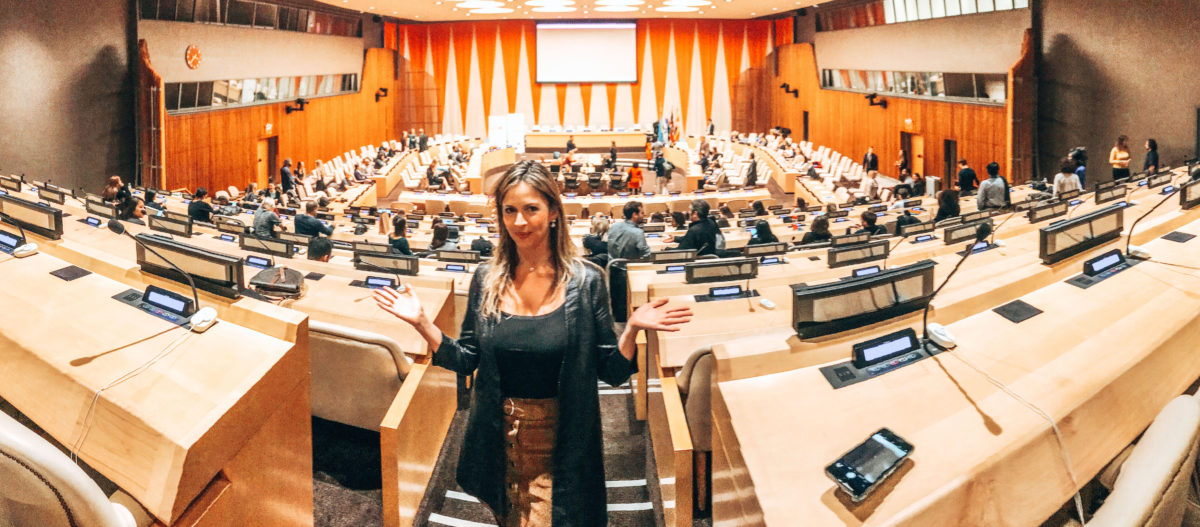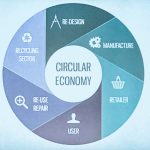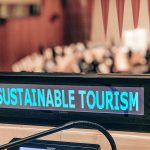In case you’ve never been to the United Nations in New York city, it’s basically like entering another dimension. The stunning, monumental structure opens up to a security situation akin to an airport TSA operation, but once you clear you are in the zone. There’s fantastic art everywhere, and massive meeting rooms where the Excellencies of our world’s nations congregate to discuss all sorts of very important matters. But I was there for a travel summit that focused on the promotion of sustainable travel, and it was our first day meeting one another. We all had seats with microphones, and little screens where the words: SUSTAINABLE TOURISM popped up. Immediately I ran into Jessica Blotter of Kind Traveler, an online booking platform I’ve recently used which donates a portion of your hotel funds to the charity of your choice. Then Norie Quintos, Editor at Large from National Geographic Travel, took the stage to welcome us. The room was buzzing and everyone was psyched to hear what was in store for us over the course of the next two days.
- Outside the UN in NYC
- Sustainable Development Goals
- Hi! I’m here!
Travel+SocialGood (who have rebranded to Impact Travel Alliance), is in the business of making sustainable tourism more accessible to all travelers. They organized this summit with partners including the Global Sustainable Tourism Council, Sustainable Travel International, the Center for Responsible Travel and Tourism Cares. But before I dig into the details…
Sustainable travel is composed of a few distinct yet related factors:
- Social
- Environmental
- Economic
Fun fact: the United Nations has declared 2017 as the International Year of Sustainable Tourism in conjunction with the Sustainable Development Goals (SDGs), an ambitious set of targets set to help solve some of the world’s most pressing issues by 2030. The SDGs are an inspiring set of long term goals, and the ITA Summit aimed to inspire radical change throughout the tourism sector to help achieve these goals through both innovative business practices and consumer behavior.
- I mean business
The theme of the summit was how to mainstream sustainable tourism by affecting the choices an average leisure or business traveler makes and the importance travel businesses put on a triple-bottom line. Myself and the other 150+ attendees were also challenged to think about increasing transparency in the industry. There is an immense amount of potential to harness the power of the travel industry and transform it into a force for good, and we all share the belief that we can change our world through travel. Furthermore, travel can also galvanize consumer demand for sustainable products. Five back-to-back talks designed around the core challenge and theme of transparency came on day 2. Speakers representing the best of class and innovative solutions to making sustainable options easily-accessible to consumers included:
- Rafat Ali, the founder of Skift
- Dylan Thuras, the founder of Atlas Obscura
- Jessica Hansen, Global Engagement Manager, Kiva
- Jessica Blotter, Co-Founder, Kind Traveler
- Russ Hedge, CEO, Hostelling International USA
- Sian Lea, Senior Program Manager, Shiva Foundation
- Mohsin Mohi-Ud-Din, Founder, MeWeSyria
Here are the main takeaways from the speakers:
- Kiva is a microfinance platform and is very transparent in order to build trust. Through Kiva you can essentially help alleviate poverty by lending to all sorts of people, giving them a chance. Their 96.9% repayment rate is proof that these investments are no joke.
- Kind Traveler taught us what $10 can do: plant 10 trees, provide 20 nutritious meals, or feed a rescued animal for 30 days. Isn’t it incredible to visualize how much of something someone in need can recieve with the money you probably spend on coffee everyday?! Kind hotel factors that Kind Traveler evaluates when collaborating with a venue include: wellness, green, and community. Kind Traveler promotes a give and get platform whereby local impact is key; 75% of travelers think its important travel dollars benefit communities they visit. Plus, the focus on the tripple win – where the charity, traveler, and the hotel all benefit is VERY cool. When your passion aligns with purpose, this can lead to economic impact. So, think about this: what’s your cause? How can this lead design and change?
- Hosteling International spoke about fusing sustainability & travel. From the environmental, economic, cultural and social aspects, all of these elements can be leveraged in new ways; spaces and places shape the cultural experience. Hosteling International uses their physical environment to raise awareness of zero waste efforts, and educate travelers on sustainable tourism!
- Booking.com spoke about their incubator program designed to support sustainably driven startups. Amsterdam based, they aim to inspire customers to drive social entrepreneurship, and collaborate with 10 companies out of 700 applicants, and grant them $500K to create their business. If you’re a startup ready to scale you should apply 🙂
- Atlas Obscura taught us how you can popularize a hidden gem through storytelling. Each day 60K people tour Venice (GROSS!) and walking through the Drubrovnik pedersatian area can take 40 mins in peak season. I hate to say that I am guilty of contributing to both of these horrific stats, though it was years ago. It’s time to rethink what the unsung wonders of the world are. For example, the Gocha falls in Peru – it’s the 3rd tallest waterfall in the world, but have you heard of it? What about the Root Bridges of Cherrapunji (which is in danger of vanishing) or the Clown Motel in Nevada that’s next to a miners graveyard? Media has power to communicate these stories to consumers at large. It’s up to us to tell the stories of incredible places and make sure they get the attention the deserve which will ultimately spread the wealth of tourist traffic on to the local economies.
All of the panels and talks were geared to address some of the 5 practices below, which serve as a framework and guide for both travelers and those in the travel business. I was surprised to learn that the Ritz Carlton has a program called ‘ambassadors of the environment’ whereby they educate guests and consumers about the ocean; I think it’s a great effort from an unexpected brand.
- Norie from Nat Geo
- Breakout work sessions
5 practices to help build a more transparent travel industry:
- Storytelling and resifting the narrative to build empathy and impact (finding the beauty and value in anything, as evidence by Atlas Obsucra’s wealth of content)
- Collaboration for the better (i.e. – Shiva Foundation tackling and preventing human trafficking and modern slavery in the UK, by facilitating a more collaborative and systemic approach to making change)
- Fuse sustainability and travel by educating and empowering community (Hostelling International’s model)
- Inspire and motivate travers to be embrace sustainable travel as a normal choice (one of ITA’s goals)
- Make the right choices as a consumer and traveler – it’s up to all of us to ACT in order to create a better world
One of the excepted outputs of the summit is a whitepaper that will compile all of the ideas developed during the Design Thinking portion of day 2, whereby groups were tasked with 1 brief: make sustainable travel mainstream. Armed with our unique backgrounds and passions to create change, we came up with questions before interviewing a random traveler in our quest to nail the brief.
Here’s a design thinking concept:
My team took a technological and platform-first approach to enable mainstream sustainable travel by leveraging consumer connectivity and digital behaviors. We plan to devise a scale that will rate the green efforts of all travel stakeholder entities, underpinned by the United Nations Sustainable Development Goals. From large scale hotels groups, boutique operations, airlines, cruise lines, and more, every organization will be assigned an icon that communicates the entitie’s sustainability efforts, shown across all relevant web properties and social media channels: Instagram, Facebook, Twitter verification, a dedicated section in the TOC of the entities’ Wikipedia page, integration with Google, and so on. The entities will be accountable to provide a transparent review of their operational activities to the United Nations, and once approved will be granted a green verification by the designated web platforms. This simple consumer indicator will allow for complete transparency across the industry irrespective of sector, and elevate consumer awareness of distinct practices, and overall contribution to a more sustainable world.
I’m working with Mandala Research on a pro-bono basis to help assemble the whitepaper, and I’m so excited to share it with you hopefully in early 2018!
What the future looks like for sustainable travel:
In 2018, ITA will begin building a comprehensive platform of vetted travel resources to help professionals gain a holistic understanding of sustainability, and implement it into their business models or own travel experiences. ITA’s goal is to provide a resource of trusted materials to those looking to learn more about sustainable tourism. ITA will first look to its current industry partners, such as Ritz-Carlton, Hostelling International USA, Lokal Travel, Kind Traveler and Myght, Inc., but will be expanding its network rapidly.
“Our goal is to reshape the narrative around sustainable tourism, and help average consumers understand that sustainability can be applied to any type of travel,” said Kelley Louise, Impact Travel Alliance’s executive director. “We believe business and leisure travel can help to solve some of the world’s most pressing issues, and hope that through collaboration, we can continue to push the industry toward a more impactful future, ” said Kelley Louise.
Facts about sustainable travel:
- The travel industry represents 10% of global GDP and employs 1 in 11 around the world. Yet on average, only $5 out of every $100 spent by travelers remains in the countries visited (according to the United Nations World Trade Organization)
- 87% of Americans purchase because they support the brand for taking a position around an issue – we expect businesses to step up for causes (source: Cone)
- 9,727 companies in over 162 counties committed to the UN global compact & SDG goals
- 73% of millennials will spend more if the product comes from a sustainable brand (Source: Nielsen)
- 9.8% of the worlds GDP came from tourism in 2015 (center for responsible travel) and 1/11 jobs worldwide
- 76% of baby boomers rate authenticity of local culture as the most important factor, and 57% on tourism in 2030 will be in emerging economies (Source: Expedia)
About Impact Travel Alliance
Impact Travel Alliance is the world’s largest community for impact-focused travel professionals. Through education and advocacy around sustainable tourism, the organization aims to transform the travel industry into a force for good, and to help solve issues like poverty and inequality through business and leisure travel. ITA is an independent 501(c)3 nonprofit with a highly engaged and active global community with 20 Hubs (local chapters) in cities around the world. ITA is run entirely by volunteers and the passion of more than 200 active Hub leaders and Media Network members. For more information, visit impacttravelalliance.org.












[…] This is an excerpt of a post that was first published on The Conscious Connoisseur. To read the post in full click here. […]